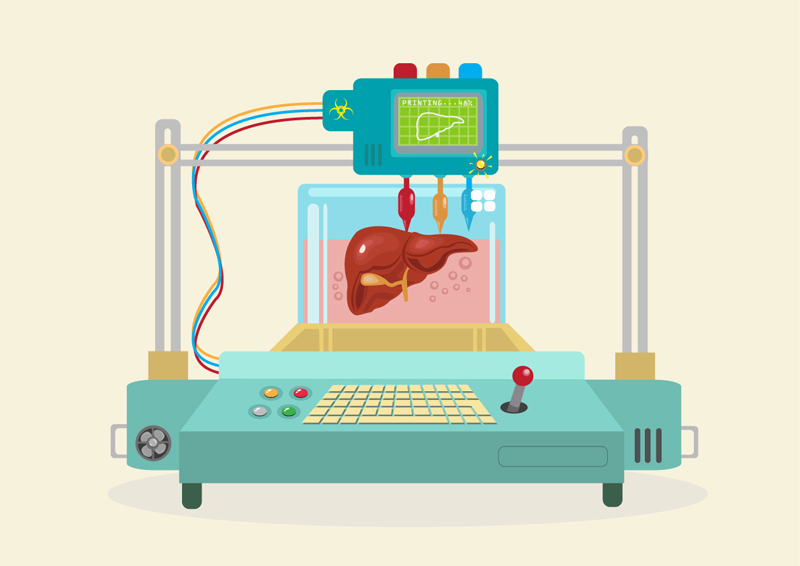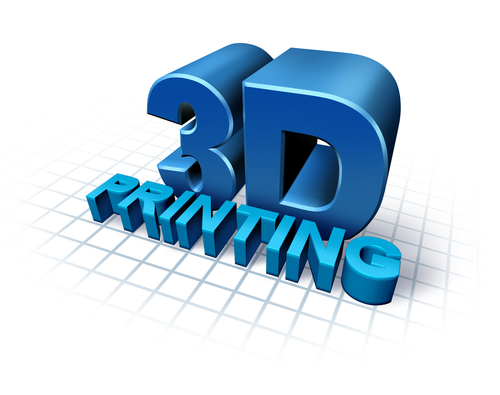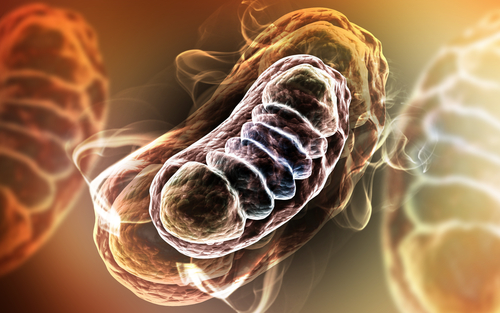Author:
T. Boland.
History:
3D printing for producing a cellular construct was first introduced in 2003, when Thomas Boland of Clemson University patented the use of inkjet printing for cells. This process utilized a modified spotting system for the deposition of cells into organized 3D matrices placed on a substrate.
This process utilized a modified spotting system for the deposition of cells into organized 3D matrices placed on a substrate.
Organs that have been successfully printed and implemented in a clinical setting are either flat, such as skin, vascular, such as blood vessels, or hollow, such as the bladder. When artificial organs are prepared for transplantation, they are often produced with the recipient’s own cells.
 More complex organs are undergoing research; these organs include the heart, pancreas, and kidneys. Estimates for when such organs can be introduced as a viable medical treatment vary.
More complex organs are undergoing research; these organs include the heart, pancreas, and kidneys. Estimates for when such organs can be introduced as a viable medical treatment vary.
In 2013, the company Organovo produced a human liver using 3D bioprinting, though it is not suitable for transplantation, and has primarily been used as a medium for drug testing.
Example:
Organs that have been successfully printed and implemented in a clinical setting are skin, blood vessels and the bladder.
Description:
3D bioprinting is the process of generating  3D printing allows for the
3D printing allows for the
3D bioprinting is being applied to regenerative medicine to address the need for tissues and organs suitable for transplantation. 3D bioprinting has already been used for the generation and transplantation of several tissues, including multilayered skin, bone, vascular grafts, tracheal splints, heart tissue and cartilaginous structures. Other applications include developing
Additions and Criticism:
 Compared with
Compared with
Publications:
- Mironov, Vladimir, Nuno Reis, and Brian Derby. «Review: bioprinting: a beginning." Tissue engineering 12.4 (2006): 631–634.
-
Derby, Brian. «Bioprinting: inkjet printing proteins and hybrid
cell-containing materials and structures." J. Mater. Chem. 18.47 (2008): 5717–5721. -
Murphy, Sean
v. , and Anthony Atala. «3D bioprinting of tissues and organs." Nature biotechnology 32.8 (2014): 773–785. -
Cui, Xiaofeng, et al. «Direct human cartilage repair using
three-dimensional bioprinting technology." Tissue Engineering Part A 18.11–12 (2012): 1304–1312.
 Owing to investigations made by L. Hayflick and
Owing to investigations made by L. Hayflick and  In adult skeletal muscle, where the resident dedicated stem cells («satellite cells») are capable of rapid and highly effective regeneration in response to injury, there is a loss of regenerative potential with age.
In adult skeletal muscle, where the resident dedicated stem cells («satellite cells») are capable of rapid and highly effective regeneration in response to injury, there is a loss of regenerative potential with age.
 Aging refers to the gradual loss of cellular function. And regeneration is the repair of damaged tissue that allows preserving tissue function in an organism. Tissue regeneration is generally mediated by
Aging refers to the gradual loss of cellular function. And regeneration is the repair of damaged tissue that allows preserving tissue function in an organism. Tissue regeneration is generally mediated by  With age, there is a gradual decline in the regenerative properties of most tissues. This decline is linked to a decreased number of stem cells, their dysfunction in
With age, there is a gradual decline in the regenerative properties of most tissues. This decline is linked to a decreased number of stem cells, their dysfunction in  Atherosclerosis provides an example of a chronic disease that involves inflammatory mechanisms. Recruitment of blood leukocytes characterizes the initiation of this disease. Its progression involves many inflammatory mediators, modulated by cells of both innate and adaptive immunity.
Atherosclerosis provides an example of a chronic disease that involves inflammatory mechanisms. Recruitment of blood leukocytes characterizes the initiation of this disease. Its progression involves many inflammatory mediators, modulated by cells of both innate and adaptive immunity.
 Inflammation is part of the complex biological response of body tissues to harmful stimuli, such as pathogens, damaged cells, or irritants.
Inflammation is part of the complex biological response of body tissues to harmful stimuli, such as pathogens, damaged cells, or irritants.
 Inflammation can be classified as either acute or chronic. Acute inflammation is the initial response of the body to harmful stimuli. Chronic inflammation is a prolonged inflammation.
Inflammation can be classified as either acute or chronic. Acute inflammation is the initial response of the body to harmful stimuli. Chronic inflammation is a prolonged inflammation.
 An inflammatory process begins as the result of a set of changes. Regulation of immune function declines during aging. Particularly, malfunctioning of niches of hemopoietic cells takes place. As the result, the amount of monocytes and macrophages, which can cause the inflammatory process in the walls of blood vessels or even in brain tissues, increase drastically. Accumulation of DNA damages and disfunctional mitochondria cause excess activation of innate immunity mechanisms. That leads to the formation of
An inflammatory process begins as the result of a set of changes. Regulation of immune function declines during aging. Particularly, malfunctioning of niches of hemopoietic cells takes place. As the result, the amount of monocytes and macrophages, which can cause the inflammatory process in the walls of blood vessels or even in brain tissues, increase drastically. Accumulation of DNA damages and disfunctional mitochondria cause excess activation of innate immunity mechanisms. That leads to the formation of 


 Nowadays scientific papers present lots of circumstantial evidence supporting the mitochondrial theory of aging. There is a progbem though in studying mtDNA and mitochondria in general. Actually, scientists have only a few ways that allow working with mitochondrial mutations. There is no methods of genetic engineering suitable for mitochondria and nowadays, it is impossible to create mutation or gene, insert it into mithochondria and then study the cell line obtained. The only possible way is to study mutations given by the nature.
Nowadays scientific papers present lots of circumstantial evidence supporting the mitochondrial theory of aging. There is a progbem though in studying mtDNA and mitochondria in general. Actually, scientists have only a few ways that allow working with mitochondrial mutations. There is no methods of genetic engineering suitable for mitochondria and nowadays, it is impossible to create mutation or gene, insert it into mithochondria and then study the cell line obtained. The only possible way is to study mutations given by the nature.
 As an individual age, there is a decline in the work of neuroendocrine system. First of all, that leads to the decline in the production of many hormones that are necessary for normal functioning of an organism. Secondly, that affect hormones interractions. Althogether a lot of bodily changes connected with aging arise, e.g. menopause, decrease in muscle mass and increased chance of degenerative disease emergence and severity.
As an individual age, there is a decline in the work of neuroendocrine system. First of all, that leads to the decline in the production of many hormones that are necessary for normal functioning of an organism. Secondly, that affect hormones interractions. Althogether a lot of bodily changes connected with aging arise, e.g. menopause, decrease in muscle mass and increased chance of degenerative disease emergence and severity.



 «The main gland» of an organism is the pituitary gland. It produce a lot of hormones which control how other endocrine glands produce hormones. Hypothalamus and pituitary body control many essential functions of an organism, including internal temperature, blood pressure, thirst, hunger, sexual appetites, chemical and water balances, menstrual cycles.
«The main gland» of an organism is the pituitary gland. It produce a lot of hormones which control how other endocrine glands produce hormones. Hypothalamus and pituitary body control many essential functions of an organism, including internal temperature, blood pressure, thirst, hunger, sexual appetites, chemical and water balances, menstrual cycles.
 Initial postulates of the intoxication theory of aging were proposed by
Initial postulates of the intoxication theory of aging were proposed by  The theory postulates that aging is connected with the accumulation of different chemical agents in the cells and the organism can not use or throw this agents away.
The theory postulates that aging is connected with the accumulation of different chemical agents in the cells and the organism can not use or throw this agents away.
 Remaining side products simply accumulate in the cells. The only and universal way to fight these substances is to dilute them in the process of cell division. This method successfully works, but it works for dividing cells only. Multicellular organisms, such as human being, have problems with side products because a lot of cells stop dividing but continue to take part in the metabolism. Such cells, e.g. essential brain and heart cells, accumulate side products of the metabolism, and these products begin to impede cells' normal functioning.
Remaining side products simply accumulate in the cells. The only and universal way to fight these substances is to dilute them in the process of cell division. This method successfully works, but it works for dividing cells only. Multicellular organisms, such as human being, have problems with side products because a lot of cells stop dividing but continue to take part in the metabolism. Such cells, e.g. essential brain and heart cells, accumulate side products of the metabolism, and these products begin to impede cells' normal functioning.
 The main intracellular side product is lipofuscin, also known as
The main intracellular side product is lipofuscin, also known as  Nowadays, such scientists as B. Davidson and
Nowadays, such scientists as B. Davidson and  Example:
Example: According to the immunological theory, the immune system is programmed to decline its functions over time, and this fact is the main cause of aging.
According to the immunological theory, the immune system is programmed to decline its functions over time, and this fact is the main cause of aging.
 In most elderly people, immunosenescence is characterized by decreased resistance to infectious diseases and decreased protection against cancer. As the result, the risk of death becomes significantly higher in elderly age. Nowadays, death caused by such infections as pneumonia, influenza, nephritis and sepsis are on the first place among the main causes of death of people over 65 years old.
In most elderly people, immunosenescence is characterized by decreased resistance to infectious diseases and decreased protection against cancer. As the result, the risk of death becomes significantly higher in elderly age. Nowadays, death caused by such infections as pneumonia, influenza, nephritis and sepsis are on the first place among the main causes of death of people over 65 years old.
 Up to date, the immunological theory has a lot of open questions. Particularly, there is no consensus about the supreme cause of the immune system senescence. Moreover, although the role of the immune system in aging processes is established, purely immune mechanism of aging is doubtful. The immunological theory is merging with neuroendocrine and free radical theories of aging.
Up to date, the immunological theory has a lot of open questions. Particularly, there is no consensus about the supreme cause of the immune system senescence. Moreover, although the role of the immune system in aging processes is established, purely immune mechanism of aging is doubtful. The immunological theory is merging with neuroendocrine and free radical theories of aging.
 History:
History: According to the mutation accumulation theory, genes useful in early life of an individual (e.g. genes involving in reproduction) are supporting by the natural selection in contrast to genes useful in old age (e.g. genes reducing the risk of oncological or neurodegenerative diseases).
According to the mutation accumulation theory, genes useful in early life of an individual (e.g. genes involving in reproduction) are supporting by the natural selection in contrast to genes useful in old age (e.g. genes reducing the risk of oncological or neurodegenerative diseases).

 Mutations influence mainly the active genes. Therefore, accumulation of mutations in active genes only will affect the process of aging. That means these genes’ activity is associated with aging and beyond the reproductive period. The evolution assists in keeping these genes' activity in old age, and if the mutagenesis in such genes is weak, these genes will probably be able to play a positive role in the health maintenance in a senescent organism.
Mutations influence mainly the active genes. Therefore, accumulation of mutations in active genes only will affect the process of aging. That means these genes’ activity is associated with aging and beyond the reproductive period. The evolution assists in keeping these genes' activity in old age, and if the mutagenesis in such genes is weak, these genes will probably be able to play a positive role in the health maintenance in a senescent organism.